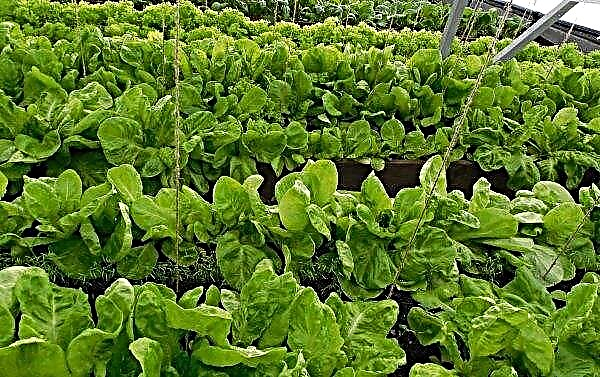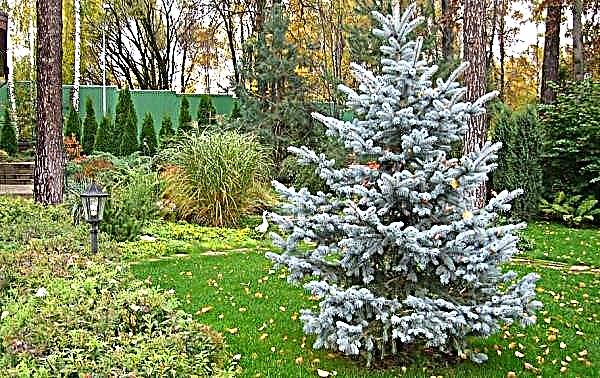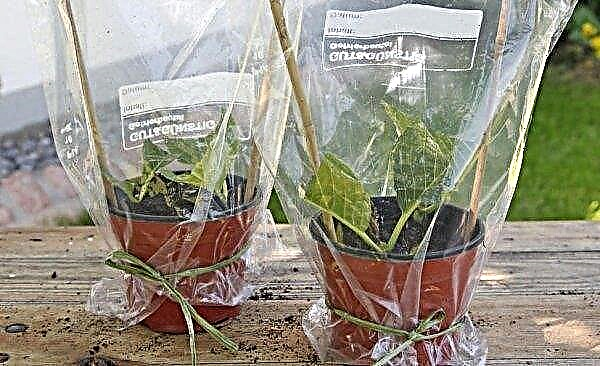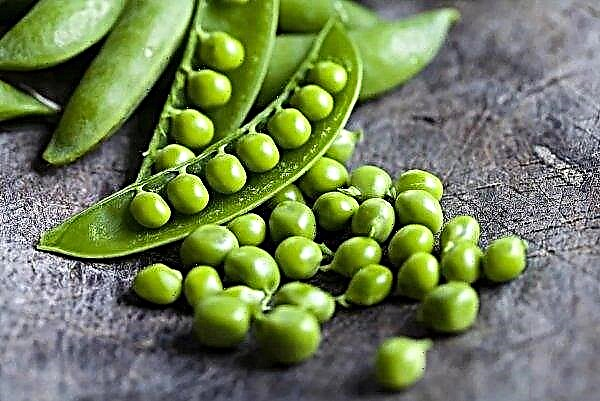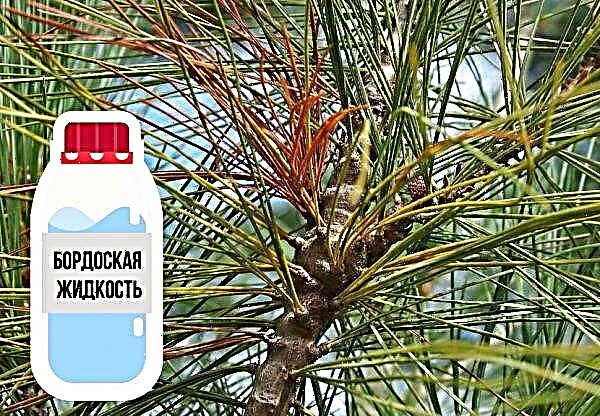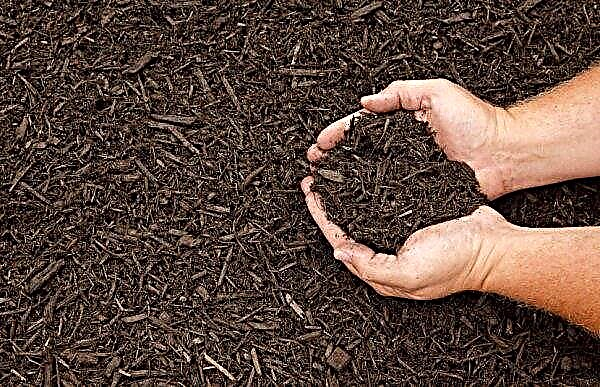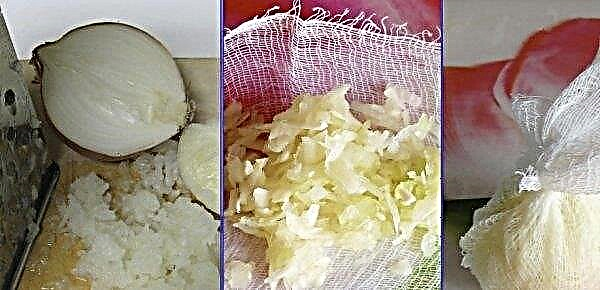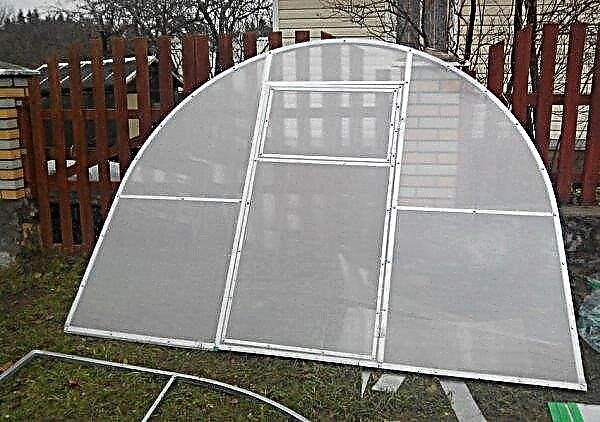The natural habitat of the Ludisia orchid is Central and East Asia. This species differs from other orchids in small flowers and large velvety leaves, for which it is also called “precious”. Consider a detailed description of the flower, the rules of care, growing and reproduction at home, as well as possible diseases and pests of this orchid.
Botanical description of the plant
In appearance, ludisia is similar to a small bush consisting of several stems. The height of the orchid is about 15 cm, but it at the same time actively grows in breadth, forming numerous side shoots. The stalk of the plant is powerful, it has a rosette of sessile leaves. The root system is able to strengthen not only on horizontal, but also on vertical surfaces due to branched short roots.
Did you know? All orchid flowers are characterized by bilateral symmetry: one half of the flower is an exact mirror image of the second half.
Ludisia leaves are large and can reach 7 cm in length and 4 cm in width. The surface of the sheet is painted in olive or purple color, it is smooth or with short villi, on which a silver pattern is noticeable. The back side of the leaf is smooth, dark brown or burgundy. In one outlet, 5-6 leaves are formed, each of which lives up to 7 years. After this time, the ludisia leaf withers and falls, and a trace in the form of a ring remains on the stem.
The flowering period of Ludisia lasts about 5 weeks and can be repeated up to 3 times a year: in autumn, winter and spring. From each rosette of leaves 1 peduncle grows, the length of which can reach 30 cm. 2-3 dozen white-yellow buds with a diameter of up to 2 cm are formed on it. The blossoming petals are white in color, and above them there are tall stamens of bright yellow color.Ludisia flowers resemble small butterflies in shape. The fruits of ludisia can be set only after artificial pollination. It can be carried out on one plant, using the pollen of one flower for pollination of another. To do this, use a toothpick to gently pry and separate the lower sticky part of the stigma of the flower, on which there are two balls of yellow or orange pollen.
Important! The pollinated flower gradually begins to fade, and in its place, over time, a pod forms.
Using a second toothpick, the pollen balls are separated from the torn stigma of the first flower and gently attached under the stigma of another flower. The main characteristics of the Ludisia orchid are presented in the table below.
| Root system | Short, branched |
| Stem | Strong, winding |
| Leaf shape | Oval, with a pointed end |
| Leaf color | Olive green |
| Flower shape | In the form of a butterfly |
| Flower color | White |
| Fruit shape | Pod |
| Fruit color | Green |
| Fruit flavor | Inedible pods |
Varieties
There are several varieties of ludisia artificially bred by breeders, each of which is highly decorative. Consider their brief description.
- Ludisia dawson. It can grow up to 30 cm in height and has large leaves covered with pink longitudinal stripes. The color of the leaves is very dark, greenish-black with a burgundy hue.
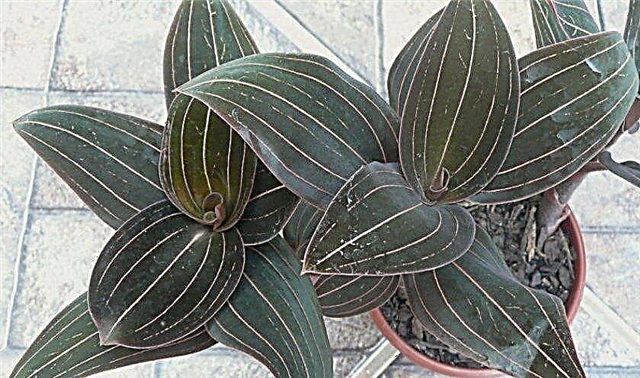
- Ludisia Odin. The outer surface of the leaves of the plant has a greenish-black color. In addition to longitudinal silver stripes on the leaves, the flower also has transverse stripes along the central silver vein.
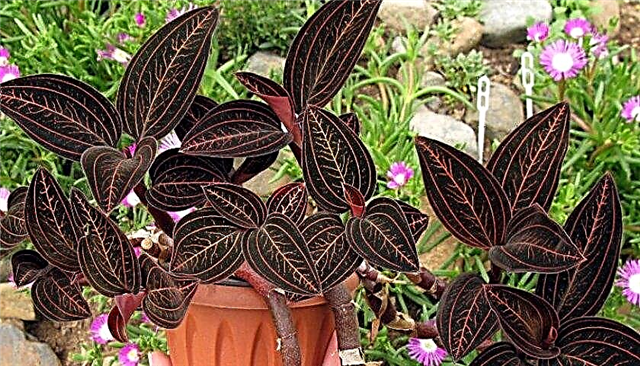
- Ludisia Alba. The flower has light green leaves that are densely covered with small white touches. They depart from the long stripes running along the leaf.
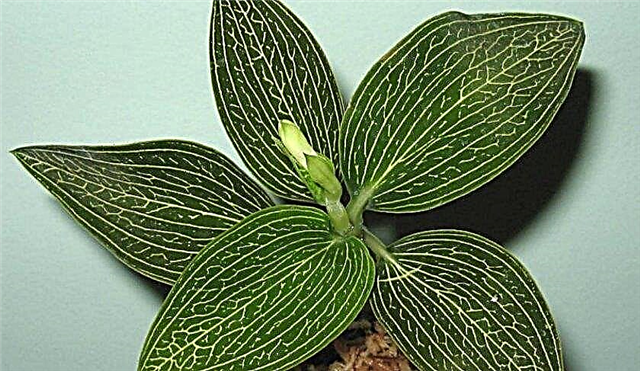
- Ludisia Otletae. Has dark, greenish-black leaves with long longitudinal stripes of red or orange.

- Ludisia Tanlaniana. The leaves of the flower are wide, have a light color and are covered with an intricate pattern of longitudinal and transverse golden stripes.

- Ludisia Velvet. Its green leaves have a bilateral velvety surface on which contrasting longitudinal stripes of red color are located.
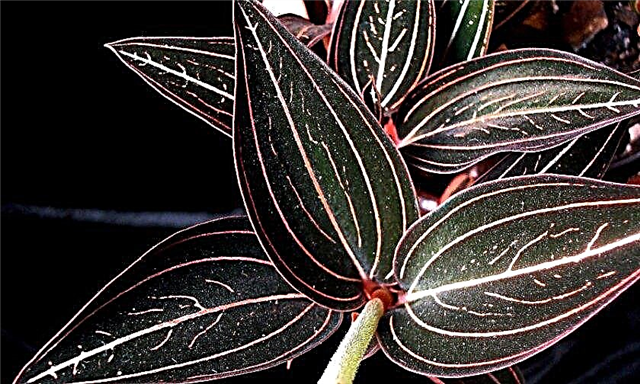
House growing conditions
Ludisia orchid belongs to unpretentious indoor plants, so it does not need specific conditions for growing. But in order for the leaves of the plant to maintain their beauty and brilliant pattern, and flowering to occur regularly, you need to provide Ludisia with the right lighting, the right humidity level and the right air temperature.
Did you know? The vanilla spice known in cooking is extracted from fruits of an orchid of the genus Vanilla.
Lighting
Ludisia orchid loves shade, but also needs a little diffused sunlight. You can put it on the windowsill, which is located under indirect rays of the sun in the morning and evening. Sunlight is needed for a beautiful and regular flowering plant. The daylight hours for Ludisia all year round should be about 12-14 hours. In winter, the flower needs to compensate for the lack of natural light and put it under a phytolamp. With insufficient light, the leaves of the ludisia are extended, and with an excess of sun, they begin to turn yellow.
The daylight hours for Ludisia all year round should be about 12-14 hours. In winter, the flower needs to compensate for the lack of natural light and put it under a phytolamp. With insufficient light, the leaves of the ludisia are extended, and with an excess of sun, they begin to turn yellow.
Ventilation
To eliminate the dry air in the room with an orchid, it is recommended to do a little airing. At the same time, you can not leave Ludisia in a draft, as this can lead to a deterioration in its appearance. In winter, during aeration, the plant can be taken out to another room to avoid too much temperature difference.
Temperature mode
Ludisia loves moderate warmth. The optimum temperature for growing plants is +20 ... + 23 ° C. In summer, the orchid can grow normally at a temperature of +29 ° C, but only if it is often watered and sprayed with water. At night, you can leave a flower even at a temperature of +17 ° C. In summer, the plant can be kept on the balcony.
Important! A slight nighttime drop in temperature is beneficial for ludisia and stimulates its lush flowering. But the difference between day and night temperature should be no more than 5–10 ° С.
Air humidity
The natural environment in which ludisia grows is characterized by an increased level of humidity. Therefore, at home, the air in a room with a flower should also be humidified. The ideal air humidity for this plant is about 70%. You can achieve this indicator with the help of simple actions:
You can achieve this indicator with the help of simple actions:
- place a flower near a room fountain, an aquarium or put it on a tray with wet pebbles;
- use automatic humidifiers;
- spray water near the plant or directly on its leaves.
Home Care
Ludisia orchid is able to maintain its decorative appearance with minimal care. But to prevent diseases and regular flowering, you need to follow a series of recommendations for proper watering, top dressing and transplanting.
Watering
The plant needs to be watered abundantly throughout the year. The higher the temperature in the room, the more often you need to water the flower. On average, it is enough to water Ludisia 1-2 times a week.
Did you know? The largest collection of orchids in the world has about 60 thousand species and is located in the National Park in Singapore.
The main recommendations for the proper watering of Ludisia are as follows:
- The plant absorbs water well only in the morning, so you need to water it in the morning.
- The substrate in the flowerpot should always be moist, but not too wet.
- For irrigation use settled, rain or boiled water with a temperature slightly higher than room temperature.
- A thick layer of drainage should be placed in the pot to prevent stagnation of water near the roots.
- The method of watering Ludisia is to immerse the pot with an orchid in a container of water for several minutes. After this, you need to get the pot out of the water and allow excess moisture to come out through the drainage holes. Then the container with an orchid can be put on a pallet.
- If water accumulates in the pan, it must be poured out so as not to provoke root rot.
- During active growth, the orchid can be placed under a warm shower with a water temperature of about +35 ° C. Before returning the plant to the room, it is necessary to wet its leaves with a cloth or paper towel and wait for them to dry completely.

Top dressing
If the soil is changed in a timely manner and the plant is transplanted into a larger pot, then ludisia will receive all the nutrients it needs from the substrate in which it is located. However, during growth and flowering, the plant needs additional fertilizing from mineral fertilizers.
The frequency of feeding depends on the season:
- In spring and summer - every 10-14 days in a concentration equal to half of the recommended on the package;
- in winter - every 30 days in the same concentration as in the summer;
- when the flower is in dormant state, do not feed.

Transfer
Ludisia transplantation can be carried out no more than once every 2-3 years. During this time, the roots of the plant usually grow so much that the pot becomes cramped and they begin to crawl out of it. It is best to carry out a transplant in the spring. When choosing a pot for this type of orchid, it is better to give preference to transparent containers with large drainage holes at the bottom. First you need to lay brick crumb or vermiculite in the pot, and then the soil.
Important! The roots of Ludisia love to grow in breadth, so the pot needs to be selected wide, with low walls.
It should consist of the following components:
- sphagnum moss - 36%;
- small pieces of pine bark, needles - 36%;
- peat - 10%;
- charcoal - 9%;
- sheet land - 9%.

The sequence of steps for a Ludisia transplant is presented below:
- Prepare the pot, put a thick layer of drainage on the bottom and fill the tank with soil halfway.
- Carefully remove the orchid from the old container, spread the roots and remove all particles of the old substrate.
- Soak the peeled flower roots in warm water for 2-3 hours.
- Place the plant in a new pot, leaving its roots in the upper layers of the soil.
- Lightly sprinkle the roots with a substrate on top.
Video: ludisia transplant
Special period
Ludisia orchid does not require special care, but it is worth adhering to certain rules at certain periods of its life cycle. It is important to provide the plant with comfortable conditions during flowering and a short dormant period.
Did you know? In Malaysia, a tiger orchid (Grammatophyllum speciosum) grows, which is the largest in the world. Its height can reach 7.5 m.
Bloom
In a good microclimate and with proper care, ludisia can bloom several times a year. In this case, flowers appear on it in the second half of autumn, in December and in March. During flowering, the plant requires a lot of strength, therefore it is necessary to fertilize and provide the orchid with enough water so that the soil in the pot is always slightly moist.
Peace
The period of complete rest in the Ludisia orchid is weakly expressed. Most often, it occurs after an active period of growth and flowering. The plant seems to hibernate, but it lasts no more than 2-3 months. The flower usually stops growing, does not release new leaves and peduncles. So he regains strength and prepares for the next phase of active growth.
During dormancy, it is recommended to keep the plant in a cool room with an air temperature of about +18 ° C. It should be watered moderately, not allowing the complete drying of the soil in the flowerpot. Fertilizers during dormancy do not contribute.
Breeding
Flower propagation is vegetative. Ludisia orchid grows year-round, almost without hibernation, so it can be propagated at any time of the year. A mixture of small pine bark and sphagnum moss is used as soil for a new young plant.
Video: Ludisia propagation
Dividing the bush
Ludisia can be propagated by dividing the bush during a planned plant transplant. Separate the bush is only if the flower has 5-6 processes. This method is the fastest, but requires careful handling of the roots.
Important! If you damage the roots during the division of the bush, the plant may die.
Step-by-step instructions for propagating ludisia by dividing the bush:
- Carefully remove the orchid from the pot. Spread its roots and clean them of adhering soil.
- Divide the bush into two parts so that each of them contains at least 2-3 processes.
- Place each part in an individual pot with prepared substrate.
- Sprinkle the roots on top with small parts of the substrate.
Cuttings
Propagation by cuttings is the simplest and fastest, even for a beginner grower. Consider a detailed description of this process:
Consider a detailed description of this process:
- Prepare a sharp blade and disinfect it.
- Using a blade, cut several pieces from the stem so that 2-3 internodes are located on each.
- The places of the cut are covered with powdered charcoal.
- Put the handle on the surface of the soil and gently push it deep into. It is not necessary to sprinkle it on top with soil.
- Cover the pot with the handle with a film and leave for 15-30 days for rooting.
- After a specified period of time, small roots should appear on the handle. The film from the pot can be removed only after the appearance of the first leaves. At first, it is worth leaving the plant without shelter for a couple of hours, then gradually increase the time spent without a film.
Important! If a peduncle is formed on a young sprout - it needs to be cut. Flowering will take away all the strength from a young orchid, slow down the growth of its stem and leaves.
Growing difficulties
With proper care, the Ludisia orchid is not susceptible to disease or pest attack. But with non-compliance with the temperature regime or improper watering, problems arise that lead to a deterioration in the appearance of the flower. In order to save the plant in time and prevent its death, you need to know about the possible difficulties that arise during the cultivation of ludisia, and the rules for their elimination.
In order to save the plant in time and prevent its death, you need to know about the possible difficulties that arise during the cultivation of ludisia, and the rules for their elimination.
- Mealybug. White lumps, similar to cotton wool, appear on the leaves of the orchid. The cause of the appearance is dry air. The plant must be treated with insecticides.
- Whitefly Lays eggs on the back of the leaf and covers its outer part with a sticky white coating. Larvae hatching from the eggs, eating the leaves of a flower. First, the plant must be cleaned of pests with a cotton swab dipped in a soap solution, then spray the orchid with insecticides.
- Spider mite. Appears in a warm room with dry air and wraps leaves with a white web. Pests are removed using special insect repellents. To prevent their reappearance, the flower should be moved to a cooler room with a high level of humidity.
- Shield. A sign of its appearance is a sticky coating on the leaves. The cause of the pest is also too dry air in the room.The flower should be sprayed with special preparations and increase the level of humidity in the room.
- Sunburn. Appear when exposed to the leaves of Ludisia direct sunlight. The flower must be rearranged in partial shade.
- Yellowing and dry leaf tips. Appears when placing a flower near batteries or other sources of heat. To fix the problem, it is necessary to remove the ludisia from the heaters.
- Root rot. It occurs with excessive watering or poor drainage in a flower pot. To combat the disease, the orchid should be transplanted into a new substrate, laying a thick layer of drainage on the bottom of the pot. Watering should be reduced.
Ludisia orchid attracts gardeners with its beautiful iridescent leaves, and its cultivation is not difficult even for beginners. Fulfillment of all the described recommendations for caring for the plant will allow you to grow a beautiful and blooming ludisia, which will become an adornment of any room.








